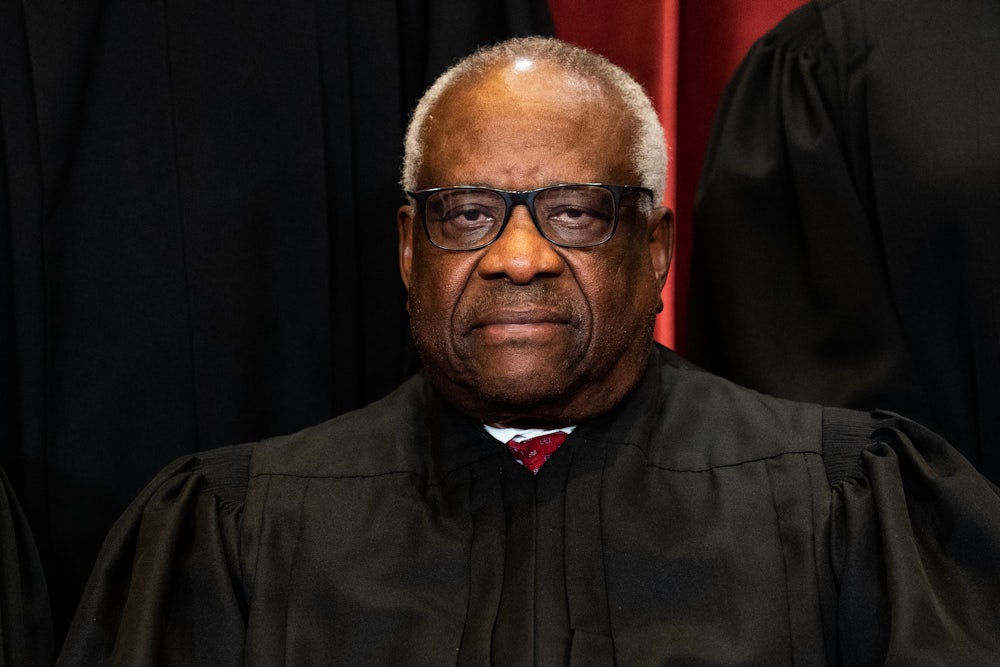Last year, when it struck down New York’s concealed-carry law, the Supreme Court upended how the courts scrutinize gun regulations by creating an unusual new test for them: Their constitutionality must be weighed by whether or not similar laws existed when the Second Amendment was ratified all the way back in 1791.
“When the Second Amendment’s plain text covers an individual’s conduct, the Constitution presumptively protects that conduct,” Justice Clarence Thomas wrote for the court in New York State Pistol and Rifle Association v. Bruen. “The government must then justify its regulation by demonstrating that it is consistent with the nation’s historical tradition of firearm regulation. Only then may a court conclude that the individual’s conduct falls outside the Second Amendment’s ‘unqualified command.’”
Originalism—which asserts that the Constitution must be interpreted based on its original public meaning—has been in ascendance on the right for years, but the Bruen ruling may have been the most brazen application yet of the legal doctrine. It may also have been the sloppiest, as the justices seemed to implicitly acknowledge in oral arguments on Tuesday in a separate gun case.
It fell to Solicitor General Elizabeth Prelogar, arguing on behalf of the federal government in United States v. Rahimi, to explicitly poke holes in the “historical tradition” test. She didn’t ask the court to overturn Bruen outright—likely a tactical decision, given that she urged the justices not to strike down the New York concealed-carry law last year—and instead asked the justices to “clarify” some aspects of this new historical test for gun laws.
Prelogar noted that the opposing lawyer in Rahimi, who was challenging a federal law banning gun ownership for people under domestic violence protection orders, had argued that the government must find a nearly exact historical analogue after Bruen to uphold a modern gun restriction. “I think that is a clearly incorrect reading of Bruen,” she told the justices. “Unfortunately, it’s a profound misreading that many lower courts have been adopting. And I think that it’s important for the court to understand the destabilizing consequences of that reading in the lower courts.”
None of the justices really challenged this framing, because it was a polite way for them to save face. The problem isn’t that the lower courts have been “misreading” Bruen. To the contrary, it’s that they’ve been correctly reading Bruen and taking it to its logical conclusion. That decision made the Rahimi challenge inevitable, and now it’s up to the justices to clean up the mess.
Since the Supreme Court in 2008 recognized an individual right to bear arms in the Second Amendment, many federal courts had engaged in a cost-benefit analysis of gun laws—and indeed upheld most existing gun regulations by accepting the government’s stated interest in preventing gun deaths. But Thomas, who had long complained that this approach turned the Second Amendment into a “second-class right,” used Bruen to quash it in favor of an originalist one. Under the history-and-tradition test, courts can only look to whether the regulation in question had a “historical analogue” in the late eighteenth and early nineteenth centuries. If one couldn’t be found, then the restriction apparently ran counter to the original public meaning of the Second Amendment as early Americans would have understood it.
However reasonable this test sounded in theory—and it apparently sounded reasonable enough for five other justices to join Thomas’s opinion—it has been something entirely else in practice. Wielding the history-and-tradition test, federal judges have invalidated a wide range of gun restrictions in the year since Bruen was handed down, including bans on gun possession for people with felony convictions and for people with substance-abuse issues. Some have been overturned on appeal; others, like the Rahimi case, have not.
One issue with the Bruen test is the level of generality that courts must use when looking for historical analogues. Thomas, writing in Bruen, noted that judges need not find a “historical twin” or a “dead ringer for historical precursors” in the founding era for an existing law to survive. He noted, by way of example, that while states did not restrict gun possession in what are now called “sensitive places” like courthouses and polling places, “we are also aware of no disputes regarding the lawfulness of such prohibitions.” But beyond that, he offered few guideposts, thereby giving lower court judges broad discretion to read it as narrowly or broadly as they wished.
This problem is not limited to the domestic violence context. What counts as “historical evidence” or a “historical analogue” is open to interpretation. A federal judge in New Jersey, for example, struck down a ban on carrying firearms in casinos even though there were no casinos in the Thirteen Colonies and therefore no historical analogues to be found. She instead noted that French Louisiana had a casino in 1753, there was no evidence that it had banned firearms, and therefore neither could New Jersey.
Rahimi is a particularly vexing problem for the Bruen test because founding-era Americans did not conceptualize “domestic violence” in the same way as modern Americans, and therefore did not take any similar steps to quash it. The Fifth Circuit Court of Appeals cited that absence of historical analogues to side with Rahimi, the panel concluding in its opinion that the ban was an “outlier that our ancestors would never have accepted.” The Rahimi team adopted a similarly stark line in oral arguments on Tuesday. That prompted Justice Elena Kagan to grill federal public defender Matthew Wright, Rahimi’s attorney, about lines in his brief.
“It says, ‘The government has yet to find even a single American jurisdiction that adopted a similar ban while the founding generation walked the earth,’” Kagan said. “So is that what we should be looking for? And if we don’t find that similar ban, we say that the government has no right to do anything?” Wright said the court was bound by its own precedent. “Your Honor, I think that’s largely what Bruen says. However, I don’t think it has to be so narrow,” he told Kagan.
After some back-and-forth between lawyer and justice, Kagan remained unconvinced. “Two-hundred-some years ago, the problem of domestic violence was conceived very differently,” she explained. “People had a different understanding of the harm. People had a different understanding of the right of government to try to prevent the harm. People had different understandings with respect to pretty much every aspect of the problem. So, if you’re looking for a ban on domestic violence, it’s not going to be there.”
It was fairly clear from Kagan’s demeanor that this was a bug, not a feature, with the Bruen test. Wright then tried to defend his client by arguing that Rahimi’s protected right was to keep a gun in his own home, which he said was perfectly valid and almost sacrosanct in the Second Amendment context. But that just drew skeptical questions from both Chief Justice John Roberts and Justice Samuel Alito, two justices in the Bruen majority.
After Alito got Wright to say that he thought the government could disarm people in their own home in certain circumstances, Roberts tried to pin him down on the specificity required. “So are you suggesting, if there’s a sufficient showing of dangerousness, that can be a basis for disarming even with respect to possession in the home?” he asked Wright. An affirmative answer would be devastating for Rahimi’s case, and Wright understandably tried to dodge it by saying he’d have to see a historical example.
“Well, to the extent that’s pertinent, you don’t have any doubt that your client’s a dangerous person, do you?” Roberts replied.
“Your Honor, I would want to know what ‘dangerous person’ means at the moment,” Wright said, understandably trying to not sell out his client.
“Well, it means someone who’s shooting, you know, at people,” Roberts replied to terse laughs in the courtroom. “That’s a good start.”
Another problem with the Bruen test is that American society is fundamentally different than it was in 1791. When defending some restrictions, particularly those involving dangerousness and possession, the government and some judges have cited founding-era laws that disarmed enslaved persons, free Black Americans, and members of Native American tribes. This has led to no shortage of awkwardness in the lower courts, as one might imagine.
Prelogar, speaking for the government, said the Justice Department wasn’t citing those laws before the justices because they operated on an outdated understanding of the American political community. Justice Ketanji Brown Jackson pointedly asked Rahimi’s lawyer if he agreed. “I say you don’t look at them at all because, number one, they’re awful, they’re terrible laws,” Wright replied, alluding to some restrictions imposed by Redeemer governments after Reconstruction ended. “We should not give credence to a suggestion by a legislator in 1870 in the South.”
Jackson used the opportunity to point out that this required the courts to engage in historical cherry-picking, which would cut against Bruen’s validity. “But we have a history-and-traditions test,” she replied. “I guess I’m a little troubled by having a history-and-traditions test that also requires some sort of culling of the history so that only certain people’s history counts. So what do we do with that? Isn’t that a flaw with respect to the test?”
This isn’t the first time that originalists have had to reconcile their philosophical aspirations with practical reality. A small cottage industry exists in conservative legal circles for explaining how Brown v. Board of Education can coexist with originalism when segregated schools existed during the Fourteenth Amendment’s ratification, for example. In the same way, a clear majority of the justices, at least from the way they approached oral arguments on Tuesday, apparently do not want to arm domestic abusers with Bruen. How they “clarify” their test without admitting it was a mistake will be a formidable challenge.










